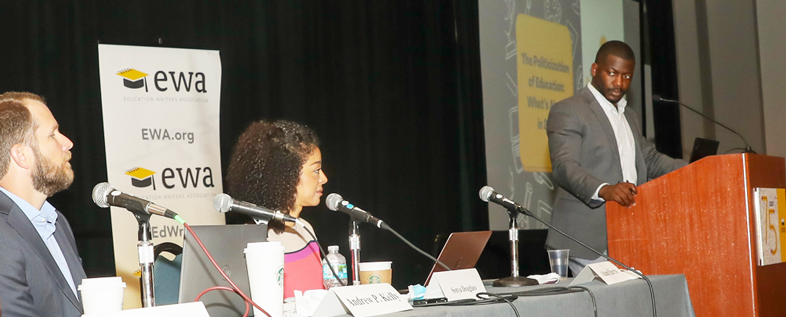Political influence over what students are learning in the classroom has been at the forefront in recent years, but its impact goes back decades.
Panelists discussed how public school districts and higher education institutions are handling the current political climate during the 2022 National Seminar in Orlando last July.
Educators are dealing with fatigue related to the ongoing COVID-19 pandemic and political stress, including accusations of teaching critical race theory to school children, researchers said.
Critical race theory is a graduate-level academic framework, often taught in law schools. Some conservative groups and activists use the term as a catch-all phrase for teaching about race and racism history in K-12 classrooms and other issues. Due to confusion about what it means, CRT is often conflated with “anti-racism,” “social justice,” and all diversity and inclusion programs.
“Public schooling is always political. It’s shaped by politics,” said Andrew Kelly, the senior vice president for strategy and policy at the University of North Carolina System Office. There also has typically been a divide among Democrats and Republicans when it comes to colleges and universities, he added.
Kelly, along with two other panelists, spoke at the “Politicization of Education: What’s Ahead in 2022” opening session, moderated by The Atlantic’s Adam Harris.
“One thing that’s clearly different: Partisan polarization is at an all-time high,” Kelly said. “That partisan polarization has now reached views about education and about schools and colleges and universities in ways that it hasn’t before.”

Cover How Political Controversies Affect School Staff
A recent study showed 48% of principals and 40% of teachers feel politics impact their job, said Heather Schwartz, director of the Pre-K to 12 educational systems program at the Rand Corporation, a research-focused, nonprofit think tank.
In comparison, only 16% of heads of households and those with non-school jobs felt politics impacted their careers. The representative survey was conducted in January 2022 as part of RAND’s State of the American Teacher and State of the American Principal projects.
“The point here is that at least the perception of the intrusion in politics [is] much, much more common as a source of stress in schools than outside of schools,” Schwartz said.
The survey also showed principals and teachers working at predominantly white suburban schools were more likely to report the intrusion of political issues and opinions as a source of stress, she said.
This doesn’t mean urban districts with high numbers of students of color are not experiencing similar issues, Schwartz said. Twenty-seven percent of leaders at large urban districts also reported that accusations of teaching critical race theory were affecting the district.
Report on How Past Affects Present
U.S. Supreme Court rulings, including Plessy v. Ferguson in 1896 and Brown v. the Board of Education of Topeka in 1954, are good examples of how politics can impact education, said Sonya Douglass, a professor of education leadership at Columbia University’s Teachers College.
The Plessy decision upheld racial segregation in schools and society based on the “separate but equal” doctrine, which allowed separate facilities for Black and white people. In Brown, justices unanimously ruled that U.S. state laws mandating racial segregation in schools were unconstitutional.
Brown is typically upheld as an example of “America’s commitment to educational equality,” Douglass said. Some view the ruling as showing how progressive the country was at the time.
She points out that critical race theory has people question “motivations and the political moment that led to the passage of that unanimous decision” in Brown.
“If you use that lens to look at the decision, it changes the way we think about whether or not it was really effective in improving educational outcomes,” Douglass said.
Investigate Locally How Politics Is Affecting K-12 and Higher Ed
Often, the push for change within schools can be traced to which political groups are in power.
“When one person sees politicization, other people see governance of a public service by elected representatives,” Kelly said, “And then when the power flips, sometimes, the perceptions flip the other way. Where if your party is no longer in power, you see it as being politicized as opposed to being governed.”
This is not only limited to elected officials.
“We see that unfolding over the last year and a half right in terms of parents literally going to their schools, to say that ‘We do not want critical race theory to be taught in our schools,’” Douglass said.
Higher education is not immune to the impact of politics.
According to Kelly, a survey of eight colleges within the University of North Carolina System showed “sizable proportions of students have concerns about stating their sincere political beliefs.” The report – originally published in May 2022 – was last updated Aug. 21, 2022.
“Self-identified conservatives express concerns about expressing their sincere political views at much higher rates than the self-described liberals,” he said.
For reporters investigating locally how partisan politics is affecting what students learn, start with school boards and other organized groups with influence:
- Follow the money: Check school board candidate spending and donation reports. Are there local, national or special-interest groups funding a board candidate’s campaign? Also, which candidates brought in the most money?
- Consider if and how your local school board has changed: Board races have traditionally been nonpartisan, but that has changed in recent years as the debate around masks and critical race theory have taken center stage.




